Marketing Management Report: An Analysis of PepsiCo's Strategies
VerifiedAdded on 2019/09/18
|20
|4943
|394
Report
AI Summary
This report provides a comprehensive analysis of PepsiCo's marketing management strategies. It begins with a company overview, including its mission, vision, and philosophy, followed by an examination of its differentiation and competitive advantages, achieved through cost leadership and differentiation strategies. The report explores PepsiCo's distribution channels, efforts to reduce commoditization, and its extensive product portfolio, including branding and brand positioning. It delves into sustainable marketing practices, monitoring programs, and consumer benefits. The analysis further examines PepsiCo's pricing strategies, marketing mix (4Ps and 4Cs), market segmentation, and experiential marketing, including customer relations and experience management. The role of IT in PepsiCo's operations is also discussed, along with its pricing and cost structure, stakeholder relationships, and commitment to the triple bottom line and sustainability. The report concludes with an overview of PepsiCo's marketing activities and overall success in the food and beverage industry.

Marketing management
Paraphrase This Document
Need a fresh take? Get an instant paraphrase of this document with our AI Paraphraser
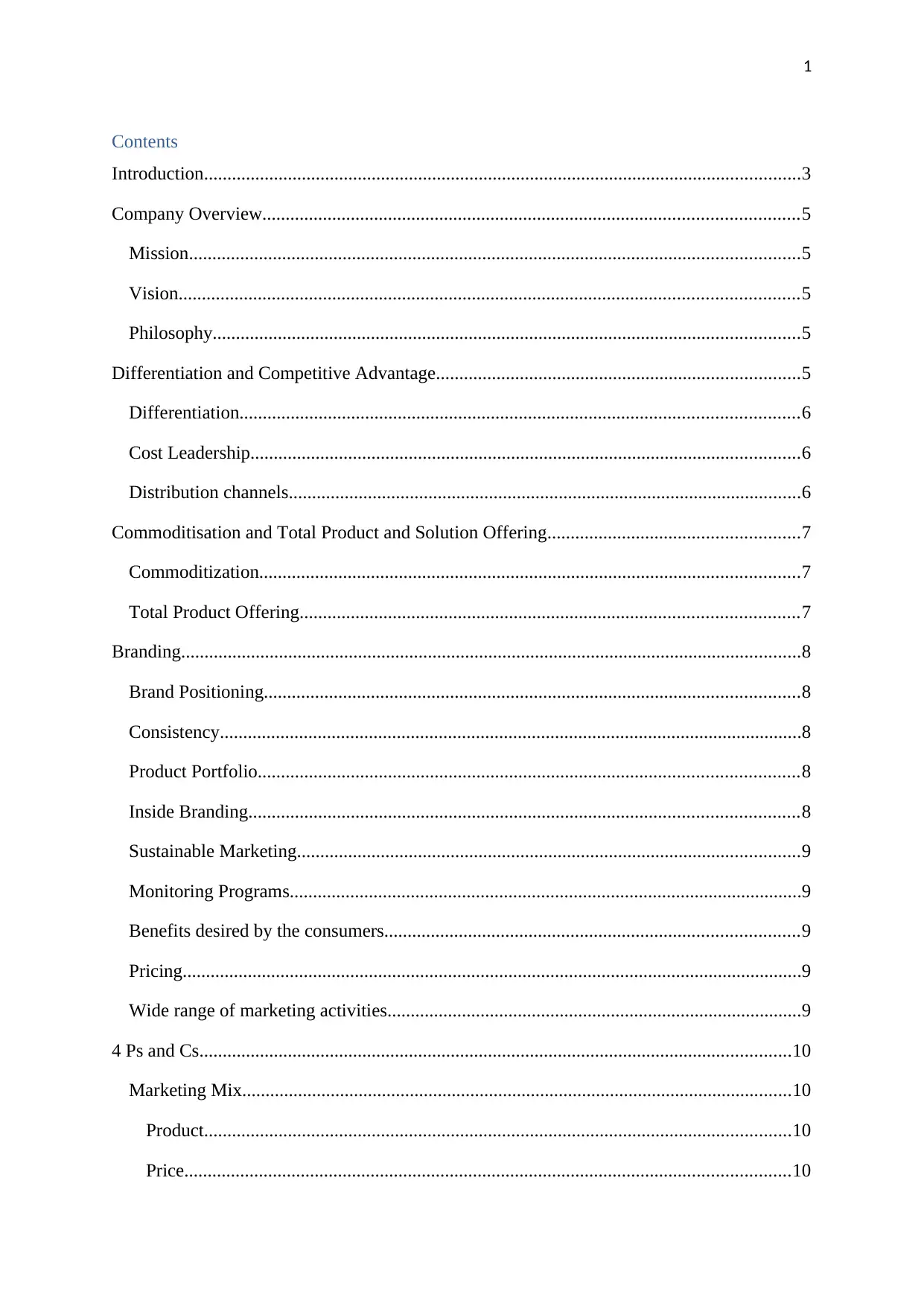
1
Contents
Introduction................................................................................................................................3
Company Overview...................................................................................................................5
Mission...................................................................................................................................5
Vision.....................................................................................................................................5
Philosophy..............................................................................................................................5
Differentiation and Competitive Advantage..............................................................................5
Differentiation........................................................................................................................6
Cost Leadership......................................................................................................................6
Distribution channels..............................................................................................................6
Commoditisation and Total Product and Solution Offering......................................................7
Commoditization....................................................................................................................7
Total Product Offering...........................................................................................................7
Branding.....................................................................................................................................8
Brand Positioning...................................................................................................................8
Consistency.............................................................................................................................8
Product Portfolio....................................................................................................................8
Inside Branding......................................................................................................................8
Sustainable Marketing............................................................................................................9
Monitoring Programs..............................................................................................................9
Benefits desired by the consumers.........................................................................................9
Pricing.....................................................................................................................................9
Wide range of marketing activities.........................................................................................9
4 Ps and Cs...............................................................................................................................10
Marketing Mix......................................................................................................................10
Product..............................................................................................................................10
Price..................................................................................................................................10
Contents
Introduction................................................................................................................................3
Company Overview...................................................................................................................5
Mission...................................................................................................................................5
Vision.....................................................................................................................................5
Philosophy..............................................................................................................................5
Differentiation and Competitive Advantage..............................................................................5
Differentiation........................................................................................................................6
Cost Leadership......................................................................................................................6
Distribution channels..............................................................................................................6
Commoditisation and Total Product and Solution Offering......................................................7
Commoditization....................................................................................................................7
Total Product Offering...........................................................................................................7
Branding.....................................................................................................................................8
Brand Positioning...................................................................................................................8
Consistency.............................................................................................................................8
Product Portfolio....................................................................................................................8
Inside Branding......................................................................................................................8
Sustainable Marketing............................................................................................................9
Monitoring Programs..............................................................................................................9
Benefits desired by the consumers.........................................................................................9
Pricing.....................................................................................................................................9
Wide range of marketing activities.........................................................................................9
4 Ps and Cs...............................................................................................................................10
Marketing Mix......................................................................................................................10
Product..............................................................................................................................10
Price..................................................................................................................................10
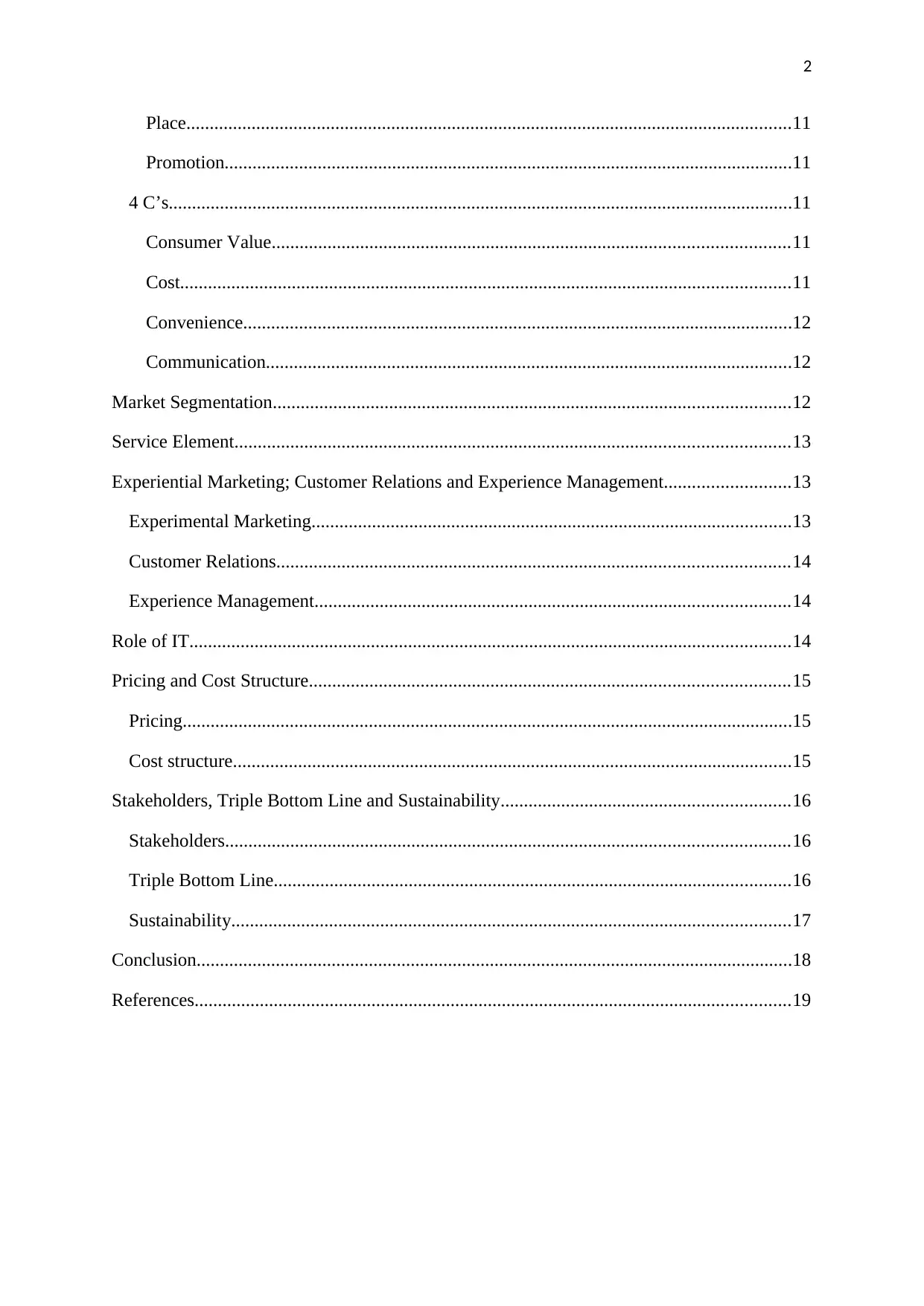
2
Place..................................................................................................................................11
Promotion..........................................................................................................................11
4 C’s......................................................................................................................................11
Consumer Value...............................................................................................................11
Cost...................................................................................................................................11
Convenience......................................................................................................................12
Communication.................................................................................................................12
Market Segmentation...............................................................................................................12
Service Element.......................................................................................................................13
Experiential Marketing; Customer Relations and Experience Management...........................13
Experimental Marketing.......................................................................................................13
Customer Relations..............................................................................................................14
Experience Management......................................................................................................14
Role of IT.................................................................................................................................14
Pricing and Cost Structure.......................................................................................................15
Pricing...................................................................................................................................15
Cost structure........................................................................................................................15
Stakeholders, Triple Bottom Line and Sustainability..............................................................16
Stakeholders.........................................................................................................................16
Triple Bottom Line...............................................................................................................16
Sustainability........................................................................................................................17
Conclusion................................................................................................................................18
References................................................................................................................................19
Place..................................................................................................................................11
Promotion..........................................................................................................................11
4 C’s......................................................................................................................................11
Consumer Value...............................................................................................................11
Cost...................................................................................................................................11
Convenience......................................................................................................................12
Communication.................................................................................................................12
Market Segmentation...............................................................................................................12
Service Element.......................................................................................................................13
Experiential Marketing; Customer Relations and Experience Management...........................13
Experimental Marketing.......................................................................................................13
Customer Relations..............................................................................................................14
Experience Management......................................................................................................14
Role of IT.................................................................................................................................14
Pricing and Cost Structure.......................................................................................................15
Pricing...................................................................................................................................15
Cost structure........................................................................................................................15
Stakeholders, Triple Bottom Line and Sustainability..............................................................16
Stakeholders.........................................................................................................................16
Triple Bottom Line...............................................................................................................16
Sustainability........................................................................................................................17
Conclusion................................................................................................................................18
References................................................................................................................................19
⊘ This is a preview!⊘
Do you want full access?
Subscribe today to unlock all pages.

Trusted by 1+ million students worldwide
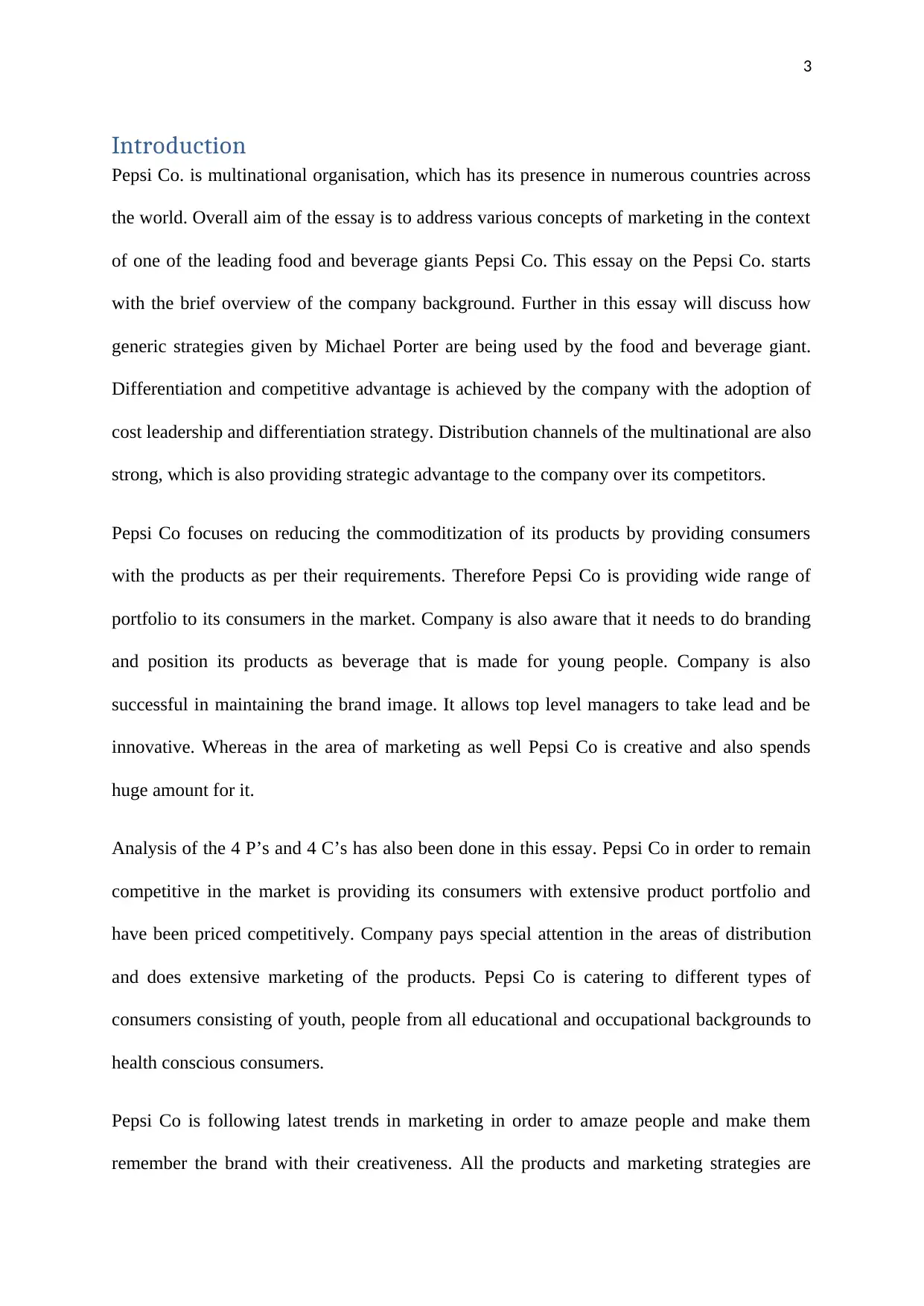
3
Introduction
Pepsi Co. is multinational organisation, which has its presence in numerous countries across
the world. Overall aim of the essay is to address various concepts of marketing in the context
of one of the leading food and beverage giants Pepsi Co. This essay on the Pepsi Co. starts
with the brief overview of the company background. Further in this essay will discuss how
generic strategies given by Michael Porter are being used by the food and beverage giant.
Differentiation and competitive advantage is achieved by the company with the adoption of
cost leadership and differentiation strategy. Distribution channels of the multinational are also
strong, which is also providing strategic advantage to the company over its competitors.
Pepsi Co focuses on reducing the commoditization of its products by providing consumers
with the products as per their requirements. Therefore Pepsi Co is providing wide range of
portfolio to its consumers in the market. Company is also aware that it needs to do branding
and position its products as beverage that is made for young people. Company is also
successful in maintaining the brand image. It allows top level managers to take lead and be
innovative. Whereas in the area of marketing as well Pepsi Co is creative and also spends
huge amount for it.
Analysis of the 4 P’s and 4 C’s has also been done in this essay. Pepsi Co in order to remain
competitive in the market is providing its consumers with extensive product portfolio and
have been priced competitively. Company pays special attention in the areas of distribution
and does extensive marketing of the products. Pepsi Co is catering to different types of
consumers consisting of youth, people from all educational and occupational backgrounds to
health conscious consumers.
Pepsi Co is following latest trends in marketing in order to amaze people and make them
remember the brand with their creativeness. All the products and marketing strategies are
Introduction
Pepsi Co. is multinational organisation, which has its presence in numerous countries across
the world. Overall aim of the essay is to address various concepts of marketing in the context
of one of the leading food and beverage giants Pepsi Co. This essay on the Pepsi Co. starts
with the brief overview of the company background. Further in this essay will discuss how
generic strategies given by Michael Porter are being used by the food and beverage giant.
Differentiation and competitive advantage is achieved by the company with the adoption of
cost leadership and differentiation strategy. Distribution channels of the multinational are also
strong, which is also providing strategic advantage to the company over its competitors.
Pepsi Co focuses on reducing the commoditization of its products by providing consumers
with the products as per their requirements. Therefore Pepsi Co is providing wide range of
portfolio to its consumers in the market. Company is also aware that it needs to do branding
and position its products as beverage that is made for young people. Company is also
successful in maintaining the brand image. It allows top level managers to take lead and be
innovative. Whereas in the area of marketing as well Pepsi Co is creative and also spends
huge amount for it.
Analysis of the 4 P’s and 4 C’s has also been done in this essay. Pepsi Co in order to remain
competitive in the market is providing its consumers with extensive product portfolio and
have been priced competitively. Company pays special attention in the areas of distribution
and does extensive marketing of the products. Pepsi Co is catering to different types of
consumers consisting of youth, people from all educational and occupational backgrounds to
health conscious consumers.
Pepsi Co is following latest trends in marketing in order to amaze people and make them
remember the brand with their creativeness. All the products and marketing strategies are
Paraphrase This Document
Need a fresh take? Get an instant paraphrase of this document with our AI Paraphraser
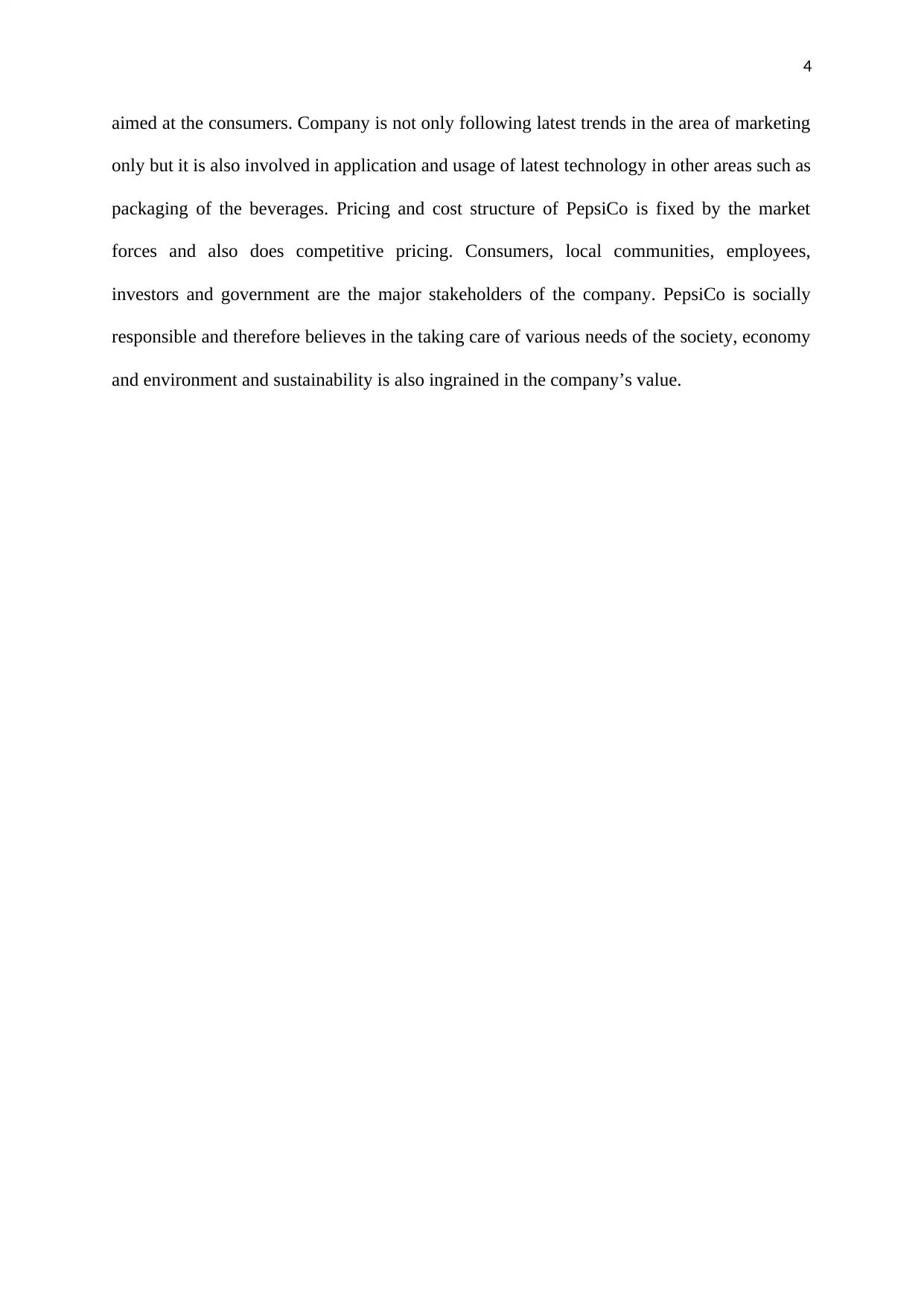
4
aimed at the consumers. Company is not only following latest trends in the area of marketing
only but it is also involved in application and usage of latest technology in other areas such as
packaging of the beverages. Pricing and cost structure of PepsiCo is fixed by the market
forces and also does competitive pricing. Consumers, local communities, employees,
investors and government are the major stakeholders of the company. PepsiCo is socially
responsible and therefore believes in the taking care of various needs of the society, economy
and environment and sustainability is also ingrained in the company’s value.
aimed at the consumers. Company is not only following latest trends in the area of marketing
only but it is also involved in application and usage of latest technology in other areas such as
packaging of the beverages. Pricing and cost structure of PepsiCo is fixed by the market
forces and also does competitive pricing. Consumers, local communities, employees,
investors and government are the major stakeholders of the company. PepsiCo is socially
responsible and therefore believes in the taking care of various needs of the society, economy
and environment and sustainability is also ingrained in the company’s value.
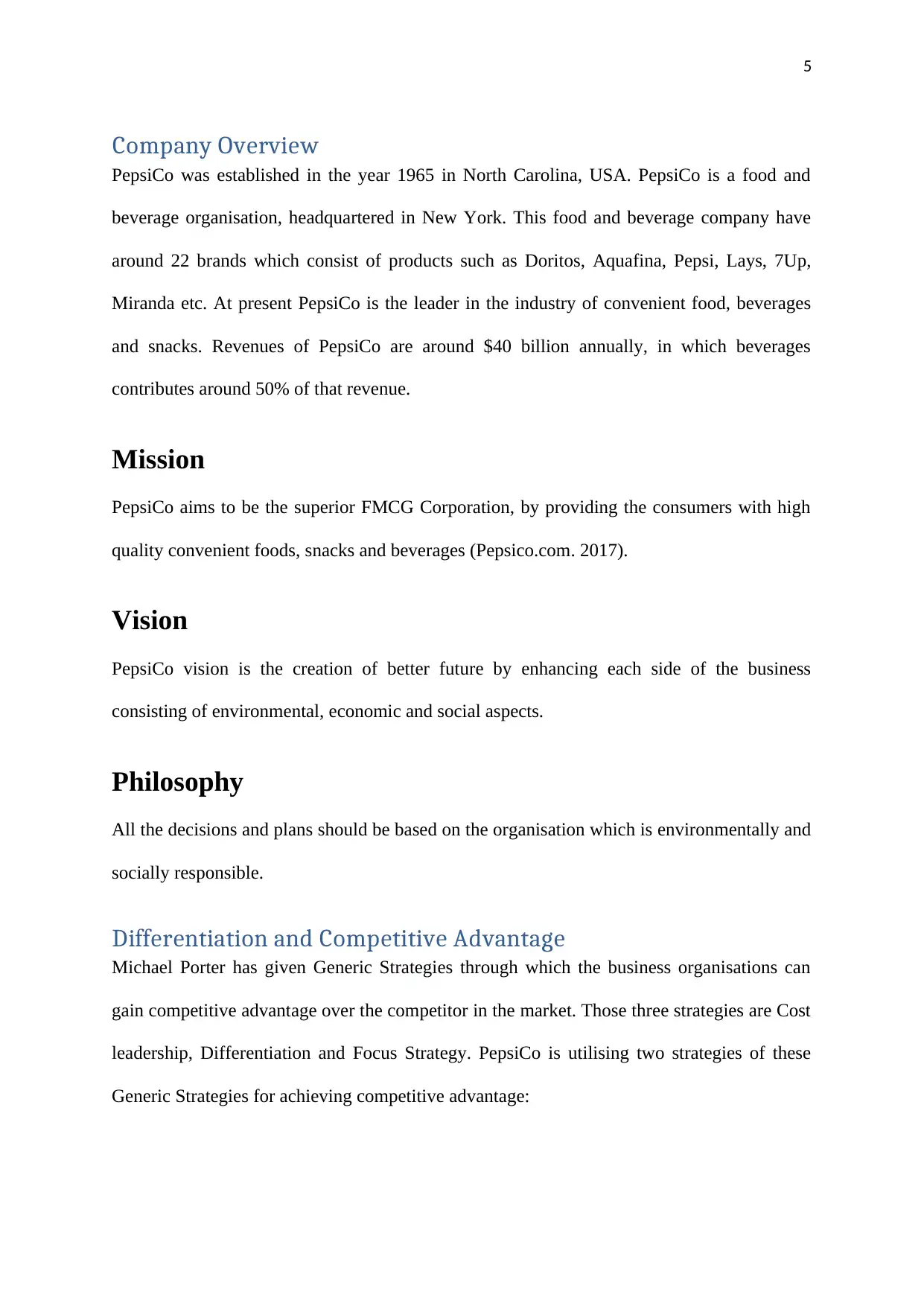
5
Company Overview
PepsiCo was established in the year 1965 in North Carolina, USA. PepsiCo is a food and
beverage organisation, headquartered in New York. This food and beverage company have
around 22 brands which consist of products such as Doritos, Aquafina, Pepsi, Lays, 7Up,
Miranda etc. At present PepsiCo is the leader in the industry of convenient food, beverages
and snacks. Revenues of PepsiCo are around $40 billion annually, in which beverages
contributes around 50% of that revenue.
Mission
PepsiCo aims to be the superior FMCG Corporation, by providing the consumers with high
quality convenient foods, snacks and beverages (Pepsico.com. 2017).
Vision
PepsiCo vision is the creation of better future by enhancing each side of the business
consisting of environmental, economic and social aspects.
Philosophy
All the decisions and plans should be based on the organisation which is environmentally and
socially responsible.
Differentiation and Competitive Advantage
Michael Porter has given Generic Strategies through which the business organisations can
gain competitive advantage over the competitor in the market. Those three strategies are Cost
leadership, Differentiation and Focus Strategy. PepsiCo is utilising two strategies of these
Generic Strategies for achieving competitive advantage:
Company Overview
PepsiCo was established in the year 1965 in North Carolina, USA. PepsiCo is a food and
beverage organisation, headquartered in New York. This food and beverage company have
around 22 brands which consist of products such as Doritos, Aquafina, Pepsi, Lays, 7Up,
Miranda etc. At present PepsiCo is the leader in the industry of convenient food, beverages
and snacks. Revenues of PepsiCo are around $40 billion annually, in which beverages
contributes around 50% of that revenue.
Mission
PepsiCo aims to be the superior FMCG Corporation, by providing the consumers with high
quality convenient foods, snacks and beverages (Pepsico.com. 2017).
Vision
PepsiCo vision is the creation of better future by enhancing each side of the business
consisting of environmental, economic and social aspects.
Philosophy
All the decisions and plans should be based on the organisation which is environmentally and
socially responsible.
Differentiation and Competitive Advantage
Michael Porter has given Generic Strategies through which the business organisations can
gain competitive advantage over the competitor in the market. Those three strategies are Cost
leadership, Differentiation and Focus Strategy. PepsiCo is utilising two strategies of these
Generic Strategies for achieving competitive advantage:
⊘ This is a preview!⊘
Do you want full access?
Subscribe today to unlock all pages.

Trusted by 1+ million students worldwide
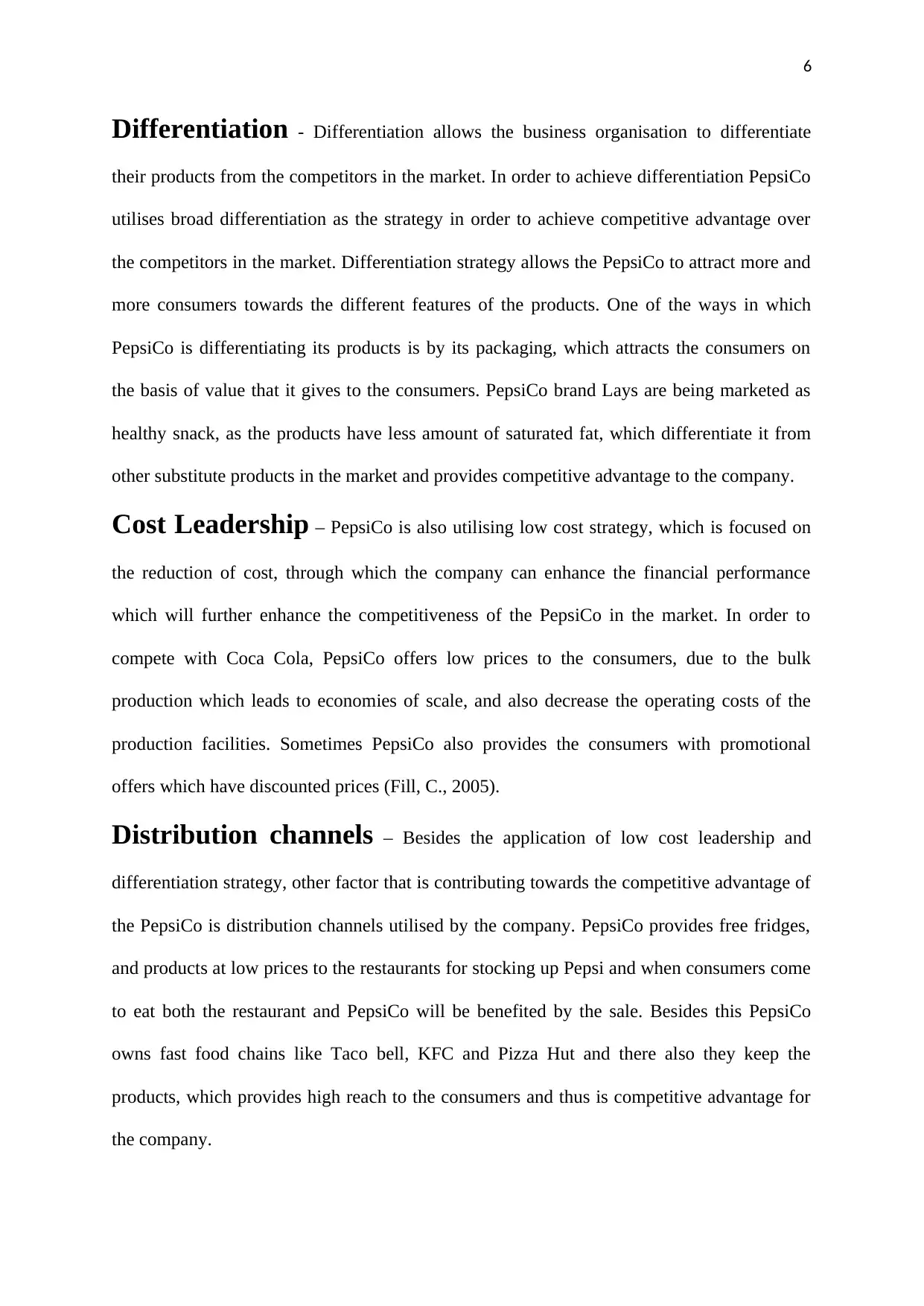
6
Differentiation - Differentiation allows the business organisation to differentiate
their products from the competitors in the market. In order to achieve differentiation PepsiCo
utilises broad differentiation as the strategy in order to achieve competitive advantage over
the competitors in the market. Differentiation strategy allows the PepsiCo to attract more and
more consumers towards the different features of the products. One of the ways in which
PepsiCo is differentiating its products is by its packaging, which attracts the consumers on
the basis of value that it gives to the consumers. PepsiCo brand Lays are being marketed as
healthy snack, as the products have less amount of saturated fat, which differentiate it from
other substitute products in the market and provides competitive advantage to the company.
Cost Leadership – PepsiCo is also utilising low cost strategy, which is focused on
the reduction of cost, through which the company can enhance the financial performance
which will further enhance the competitiveness of the PepsiCo in the market. In order to
compete with Coca Cola, PepsiCo offers low prices to the consumers, due to the bulk
production which leads to economies of scale, and also decrease the operating costs of the
production facilities. Sometimes PepsiCo also provides the consumers with promotional
offers which have discounted prices (Fill, C., 2005).
Distribution channels – Besides the application of low cost leadership and
differentiation strategy, other factor that is contributing towards the competitive advantage of
the PepsiCo is distribution channels utilised by the company. PepsiCo provides free fridges,
and products at low prices to the restaurants for stocking up Pepsi and when consumers come
to eat both the restaurant and PepsiCo will be benefited by the sale. Besides this PepsiCo
owns fast food chains like Taco bell, KFC and Pizza Hut and there also they keep the
products, which provides high reach to the consumers and thus is competitive advantage for
the company.
Differentiation - Differentiation allows the business organisation to differentiate
their products from the competitors in the market. In order to achieve differentiation PepsiCo
utilises broad differentiation as the strategy in order to achieve competitive advantage over
the competitors in the market. Differentiation strategy allows the PepsiCo to attract more and
more consumers towards the different features of the products. One of the ways in which
PepsiCo is differentiating its products is by its packaging, which attracts the consumers on
the basis of value that it gives to the consumers. PepsiCo brand Lays are being marketed as
healthy snack, as the products have less amount of saturated fat, which differentiate it from
other substitute products in the market and provides competitive advantage to the company.
Cost Leadership – PepsiCo is also utilising low cost strategy, which is focused on
the reduction of cost, through which the company can enhance the financial performance
which will further enhance the competitiveness of the PepsiCo in the market. In order to
compete with Coca Cola, PepsiCo offers low prices to the consumers, due to the bulk
production which leads to economies of scale, and also decrease the operating costs of the
production facilities. Sometimes PepsiCo also provides the consumers with promotional
offers which have discounted prices (Fill, C., 2005).
Distribution channels – Besides the application of low cost leadership and
differentiation strategy, other factor that is contributing towards the competitive advantage of
the PepsiCo is distribution channels utilised by the company. PepsiCo provides free fridges,
and products at low prices to the restaurants for stocking up Pepsi and when consumers come
to eat both the restaurant and PepsiCo will be benefited by the sale. Besides this PepsiCo
owns fast food chains like Taco bell, KFC and Pizza Hut and there also they keep the
products, which provides high reach to the consumers and thus is competitive advantage for
the company.
Paraphrase This Document
Need a fresh take? Get an instant paraphrase of this document with our AI Paraphraser
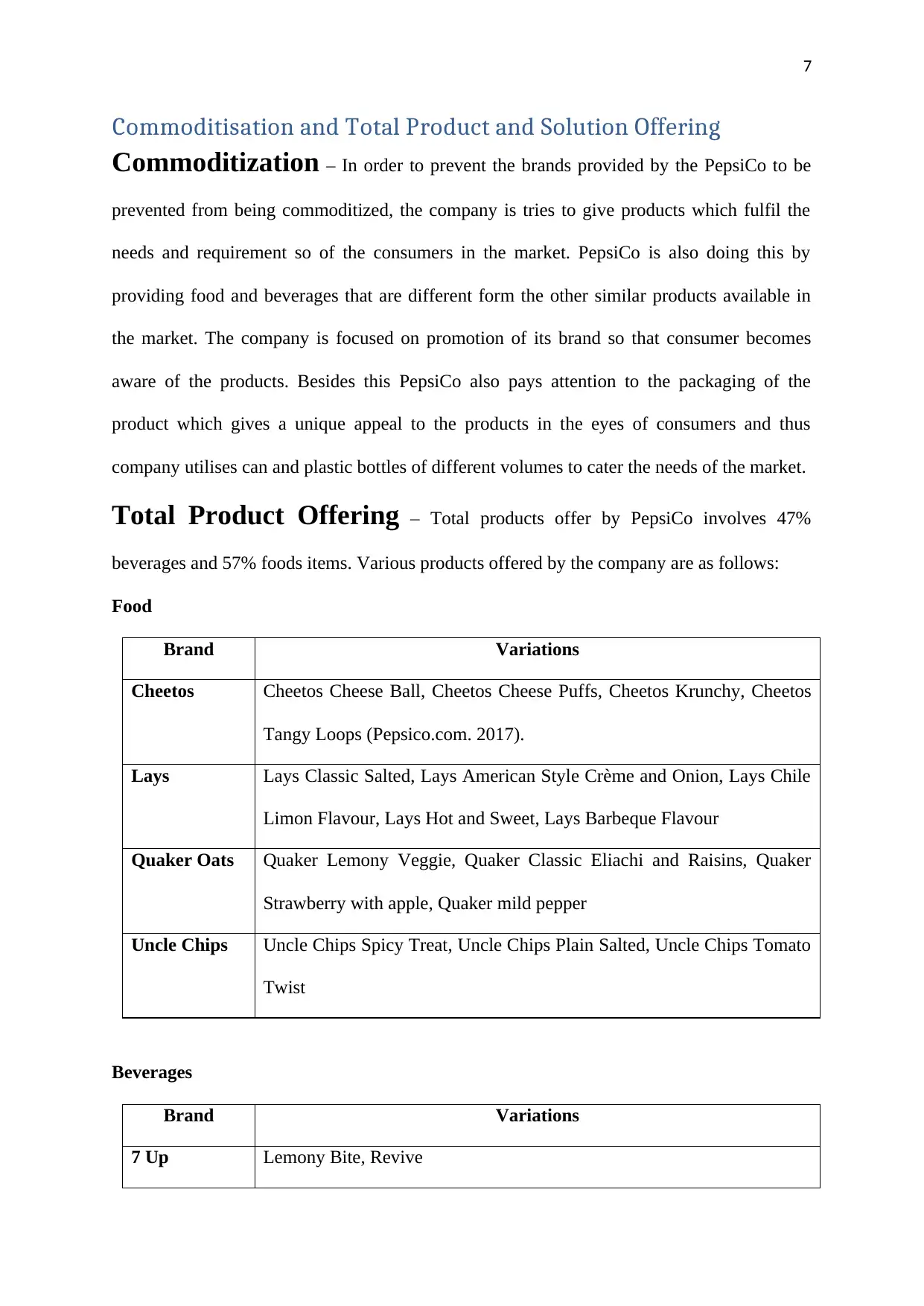
7
Commoditisation and Total Product and Solution Offering
Commoditization – In order to prevent the brands provided by the PepsiCo to be
prevented from being commoditized, the company is tries to give products which fulfil the
needs and requirement so of the consumers in the market. PepsiCo is also doing this by
providing food and beverages that are different form the other similar products available in
the market. The company is focused on promotion of its brand so that consumer becomes
aware of the products. Besides this PepsiCo also pays attention to the packaging of the
product which gives a unique appeal to the products in the eyes of consumers and thus
company utilises can and plastic bottles of different volumes to cater the needs of the market.
Total Product Offering – Total products offer by PepsiCo involves 47%
beverages and 57% foods items. Various products offered by the company are as follows:
Food
Brand Variations
Cheetos Cheetos Cheese Ball, Cheetos Cheese Puffs, Cheetos Krunchy, Cheetos
Tangy Loops (Pepsico.com. 2017).
Lays Lays Classic Salted, Lays American Style Crème and Onion, Lays Chile
Limon Flavour, Lays Hot and Sweet, Lays Barbeque Flavour
Quaker Oats Quaker Lemony Veggie, Quaker Classic Eliachi and Raisins, Quaker
Strawberry with apple, Quaker mild pepper
Uncle Chips Uncle Chips Spicy Treat, Uncle Chips Plain Salted, Uncle Chips Tomato
Twist
Beverages
Brand Variations
7 Up Lemony Bite, Revive
Commoditisation and Total Product and Solution Offering
Commoditization – In order to prevent the brands provided by the PepsiCo to be
prevented from being commoditized, the company is tries to give products which fulfil the
needs and requirement so of the consumers in the market. PepsiCo is also doing this by
providing food and beverages that are different form the other similar products available in
the market. The company is focused on promotion of its brand so that consumer becomes
aware of the products. Besides this PepsiCo also pays attention to the packaging of the
product which gives a unique appeal to the products in the eyes of consumers and thus
company utilises can and plastic bottles of different volumes to cater the needs of the market.
Total Product Offering – Total products offer by PepsiCo involves 47%
beverages and 57% foods items. Various products offered by the company are as follows:
Food
Brand Variations
Cheetos Cheetos Cheese Ball, Cheetos Cheese Puffs, Cheetos Krunchy, Cheetos
Tangy Loops (Pepsico.com. 2017).
Lays Lays Classic Salted, Lays American Style Crème and Onion, Lays Chile
Limon Flavour, Lays Hot and Sweet, Lays Barbeque Flavour
Quaker Oats Quaker Lemony Veggie, Quaker Classic Eliachi and Raisins, Quaker
Strawberry with apple, Quaker mild pepper
Uncle Chips Uncle Chips Spicy Treat, Uncle Chips Plain Salted, Uncle Chips Tomato
Twist
Beverages
Brand Variations
7 Up Lemony Bite, Revive
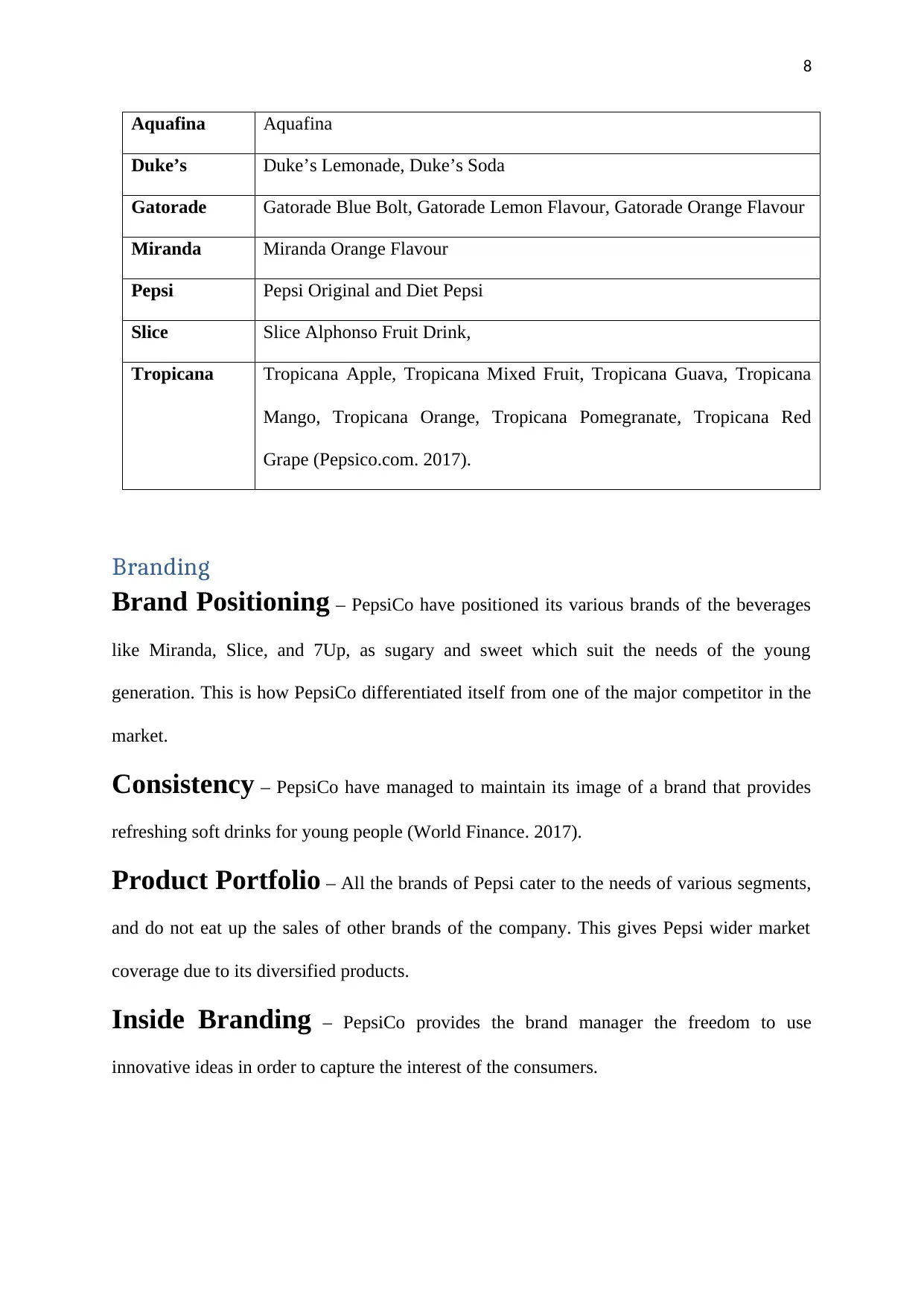
8
Aquafina Aquafina
Duke’s Duke’s Lemonade, Duke’s Soda
Gatorade Gatorade Blue Bolt, Gatorade Lemon Flavour, Gatorade Orange Flavour
Miranda Miranda Orange Flavour
Pepsi Pepsi Original and Diet Pepsi
Slice Slice Alphonso Fruit Drink,
Tropicana Tropicana Apple, Tropicana Mixed Fruit, Tropicana Guava, Tropicana
Mango, Tropicana Orange, Tropicana Pomegranate, Tropicana Red
Grape (Pepsico.com. 2017).
Branding
Brand Positioning – PepsiCo have positioned its various brands of the beverages
like Miranda, Slice, and 7Up, as sugary and sweet which suit the needs of the young
generation. This is how PepsiCo differentiated itself from one of the major competitor in the
market.
Consistency – PepsiCo have managed to maintain its image of a brand that provides
refreshing soft drinks for young people (World Finance. 2017).
Product Portfolio – All the brands of Pepsi cater to the needs of various segments,
and do not eat up the sales of other brands of the company. This gives Pepsi wider market
coverage due to its diversified products.
Inside Branding – PepsiCo provides the brand manager the freedom to use
innovative ideas in order to capture the interest of the consumers.
Aquafina Aquafina
Duke’s Duke’s Lemonade, Duke’s Soda
Gatorade Gatorade Blue Bolt, Gatorade Lemon Flavour, Gatorade Orange Flavour
Miranda Miranda Orange Flavour
Pepsi Pepsi Original and Diet Pepsi
Slice Slice Alphonso Fruit Drink,
Tropicana Tropicana Apple, Tropicana Mixed Fruit, Tropicana Guava, Tropicana
Mango, Tropicana Orange, Tropicana Pomegranate, Tropicana Red
Grape (Pepsico.com. 2017).
Branding
Brand Positioning – PepsiCo have positioned its various brands of the beverages
like Miranda, Slice, and 7Up, as sugary and sweet which suit the needs of the young
generation. This is how PepsiCo differentiated itself from one of the major competitor in the
market.
Consistency – PepsiCo have managed to maintain its image of a brand that provides
refreshing soft drinks for young people (World Finance. 2017).
Product Portfolio – All the brands of Pepsi cater to the needs of various segments,
and do not eat up the sales of other brands of the company. This gives Pepsi wider market
coverage due to its diversified products.
Inside Branding – PepsiCo provides the brand manager the freedom to use
innovative ideas in order to capture the interest of the consumers.
⊘ This is a preview!⊘
Do you want full access?
Subscribe today to unlock all pages.

Trusted by 1+ million students worldwide
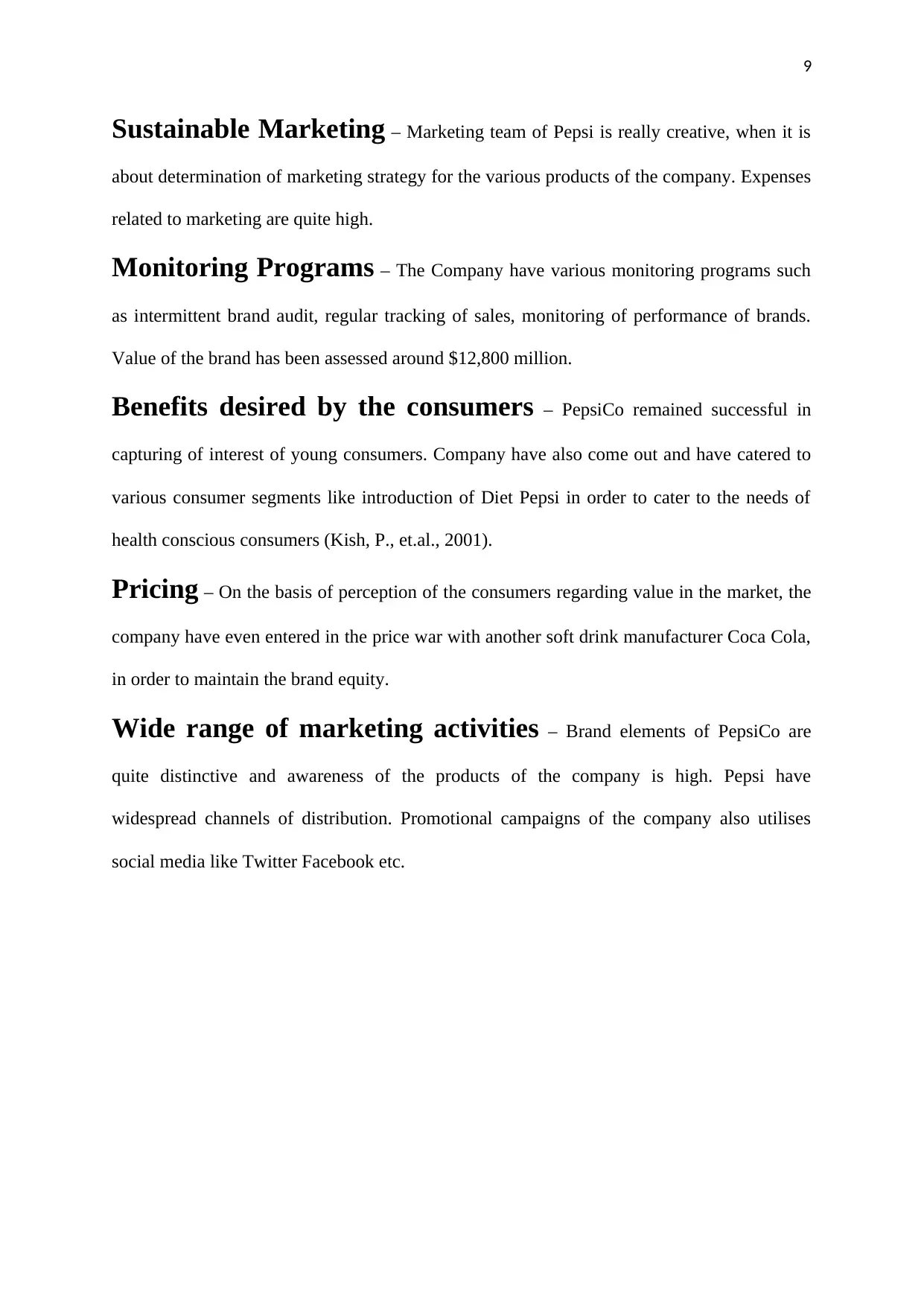
9
Sustainable Marketing – Marketing team of Pepsi is really creative, when it is
about determination of marketing strategy for the various products of the company. Expenses
related to marketing are quite high.
Monitoring Programs – The Company have various monitoring programs such
as intermittent brand audit, regular tracking of sales, monitoring of performance of brands.
Value of the brand has been assessed around $12,800 million.
Benefits desired by the consumers – PepsiCo remained successful in
capturing of interest of young consumers. Company have also come out and have catered to
various consumer segments like introduction of Diet Pepsi in order to cater to the needs of
health conscious consumers (Kish, P., et.al., 2001).
Pricing – On the basis of perception of the consumers regarding value in the market, the
company have even entered in the price war with another soft drink manufacturer Coca Cola,
in order to maintain the brand equity.
Wide range of marketing activities – Brand elements of PepsiCo are
quite distinctive and awareness of the products of the company is high. Pepsi have
widespread channels of distribution. Promotional campaigns of the company also utilises
social media like Twitter Facebook etc.
Sustainable Marketing – Marketing team of Pepsi is really creative, when it is
about determination of marketing strategy for the various products of the company. Expenses
related to marketing are quite high.
Monitoring Programs – The Company have various monitoring programs such
as intermittent brand audit, regular tracking of sales, monitoring of performance of brands.
Value of the brand has been assessed around $12,800 million.
Benefits desired by the consumers – PepsiCo remained successful in
capturing of interest of young consumers. Company have also come out and have catered to
various consumer segments like introduction of Diet Pepsi in order to cater to the needs of
health conscious consumers (Kish, P., et.al., 2001).
Pricing – On the basis of perception of the consumers regarding value in the market, the
company have even entered in the price war with another soft drink manufacturer Coca Cola,
in order to maintain the brand equity.
Wide range of marketing activities – Brand elements of PepsiCo are
quite distinctive and awareness of the products of the company is high. Pepsi have
widespread channels of distribution. Promotional campaigns of the company also utilises
social media like Twitter Facebook etc.
Paraphrase This Document
Need a fresh take? Get an instant paraphrase of this document with our AI Paraphraser
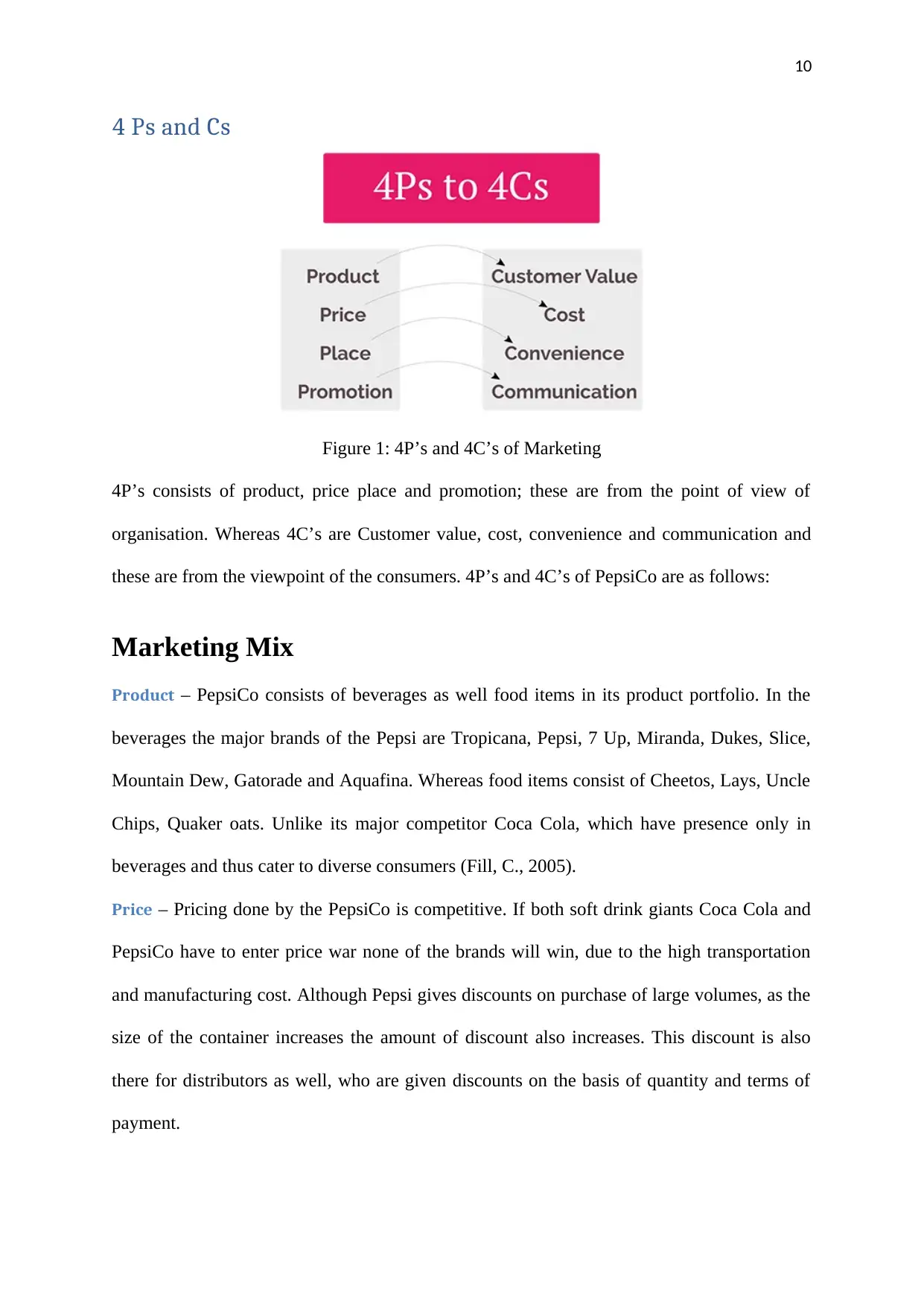
10
4 Ps and Cs
Figure 1: 4P’s and 4C’s of Marketing
4P’s consists of product, price place and promotion; these are from the point of view of
organisation. Whereas 4C’s are Customer value, cost, convenience and communication and
these are from the viewpoint of the consumers. 4P’s and 4C’s of PepsiCo are as follows:
Marketing Mix
Product – PepsiCo consists of beverages as well food items in its product portfolio. In the
beverages the major brands of the Pepsi are Tropicana, Pepsi, 7 Up, Miranda, Dukes, Slice,
Mountain Dew, Gatorade and Aquafina. Whereas food items consist of Cheetos, Lays, Uncle
Chips, Quaker oats. Unlike its major competitor Coca Cola, which have presence only in
beverages and thus cater to diverse consumers (Fill, C., 2005).
Price – Pricing done by the PepsiCo is competitive. If both soft drink giants Coca Cola and
PepsiCo have to enter price war none of the brands will win, due to the high transportation
and manufacturing cost. Although Pepsi gives discounts on purchase of large volumes, as the
size of the container increases the amount of discount also increases. This discount is also
there for distributors as well, who are given discounts on the basis of quantity and terms of
payment.
4 Ps and Cs
Figure 1: 4P’s and 4C’s of Marketing
4P’s consists of product, price place and promotion; these are from the point of view of
organisation. Whereas 4C’s are Customer value, cost, convenience and communication and
these are from the viewpoint of the consumers. 4P’s and 4C’s of PepsiCo are as follows:
Marketing Mix
Product – PepsiCo consists of beverages as well food items in its product portfolio. In the
beverages the major brands of the Pepsi are Tropicana, Pepsi, 7 Up, Miranda, Dukes, Slice,
Mountain Dew, Gatorade and Aquafina. Whereas food items consist of Cheetos, Lays, Uncle
Chips, Quaker oats. Unlike its major competitor Coca Cola, which have presence only in
beverages and thus cater to diverse consumers (Fill, C., 2005).
Price – Pricing done by the PepsiCo is competitive. If both soft drink giants Coca Cola and
PepsiCo have to enter price war none of the brands will win, due to the high transportation
and manufacturing cost. Although Pepsi gives discounts on purchase of large volumes, as the
size of the container increases the amount of discount also increases. This discount is also
there for distributors as well, who are given discounts on the basis of quantity and terms of
payment.
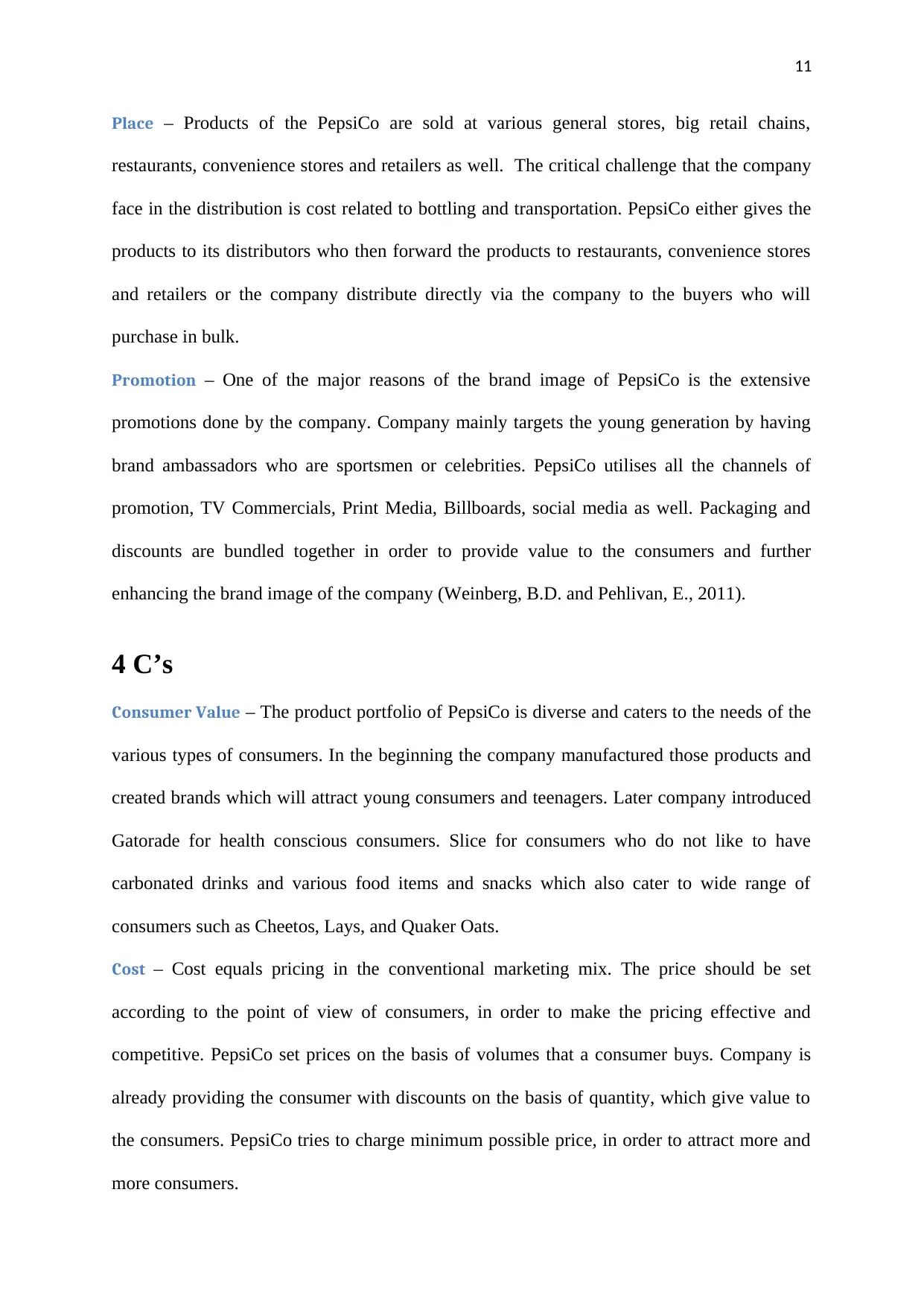
11
Place – Products of the PepsiCo are sold at various general stores, big retail chains,
restaurants, convenience stores and retailers as well. The critical challenge that the company
face in the distribution is cost related to bottling and transportation. PepsiCo either gives the
products to its distributors who then forward the products to restaurants, convenience stores
and retailers or the company distribute directly via the company to the buyers who will
purchase in bulk.
Promotion – One of the major reasons of the brand image of PepsiCo is the extensive
promotions done by the company. Company mainly targets the young generation by having
brand ambassadors who are sportsmen or celebrities. PepsiCo utilises all the channels of
promotion, TV Commercials, Print Media, Billboards, social media as well. Packaging and
discounts are bundled together in order to provide value to the consumers and further
enhancing the brand image of the company (Weinberg, B.D. and Pehlivan, E., 2011).
4 C’s
Consumer Value – The product portfolio of PepsiCo is diverse and caters to the needs of the
various types of consumers. In the beginning the company manufactured those products and
created brands which will attract young consumers and teenagers. Later company introduced
Gatorade for health conscious consumers. Slice for consumers who do not like to have
carbonated drinks and various food items and snacks which also cater to wide range of
consumers such as Cheetos, Lays, and Quaker Oats.
Cost – Cost equals pricing in the conventional marketing mix. The price should be set
according to the point of view of consumers, in order to make the pricing effective and
competitive. PepsiCo set prices on the basis of volumes that a consumer buys. Company is
already providing the consumer with discounts on the basis of quantity, which give value to
the consumers. PepsiCo tries to charge minimum possible price, in order to attract more and
more consumers.
Place – Products of the PepsiCo are sold at various general stores, big retail chains,
restaurants, convenience stores and retailers as well. The critical challenge that the company
face in the distribution is cost related to bottling and transportation. PepsiCo either gives the
products to its distributors who then forward the products to restaurants, convenience stores
and retailers or the company distribute directly via the company to the buyers who will
purchase in bulk.
Promotion – One of the major reasons of the brand image of PepsiCo is the extensive
promotions done by the company. Company mainly targets the young generation by having
brand ambassadors who are sportsmen or celebrities. PepsiCo utilises all the channels of
promotion, TV Commercials, Print Media, Billboards, social media as well. Packaging and
discounts are bundled together in order to provide value to the consumers and further
enhancing the brand image of the company (Weinberg, B.D. and Pehlivan, E., 2011).
4 C’s
Consumer Value – The product portfolio of PepsiCo is diverse and caters to the needs of the
various types of consumers. In the beginning the company manufactured those products and
created brands which will attract young consumers and teenagers. Later company introduced
Gatorade for health conscious consumers. Slice for consumers who do not like to have
carbonated drinks and various food items and snacks which also cater to wide range of
consumers such as Cheetos, Lays, and Quaker Oats.
Cost – Cost equals pricing in the conventional marketing mix. The price should be set
according to the point of view of consumers, in order to make the pricing effective and
competitive. PepsiCo set prices on the basis of volumes that a consumer buys. Company is
already providing the consumer with discounts on the basis of quantity, which give value to
the consumers. PepsiCo tries to charge minimum possible price, in order to attract more and
more consumers.
⊘ This is a preview!⊘
Do you want full access?
Subscribe today to unlock all pages.

Trusted by 1+ million students worldwide
1 out of 20
Related Documents
Your All-in-One AI-Powered Toolkit for Academic Success.
+13062052269
info@desklib.com
Available 24*7 on WhatsApp / Email
![[object Object]](/_next/static/media/star-bottom.7253800d.svg)
Unlock your academic potential
Copyright © 2020–2025 A2Z Services. All Rights Reserved. Developed and managed by ZUCOL.





